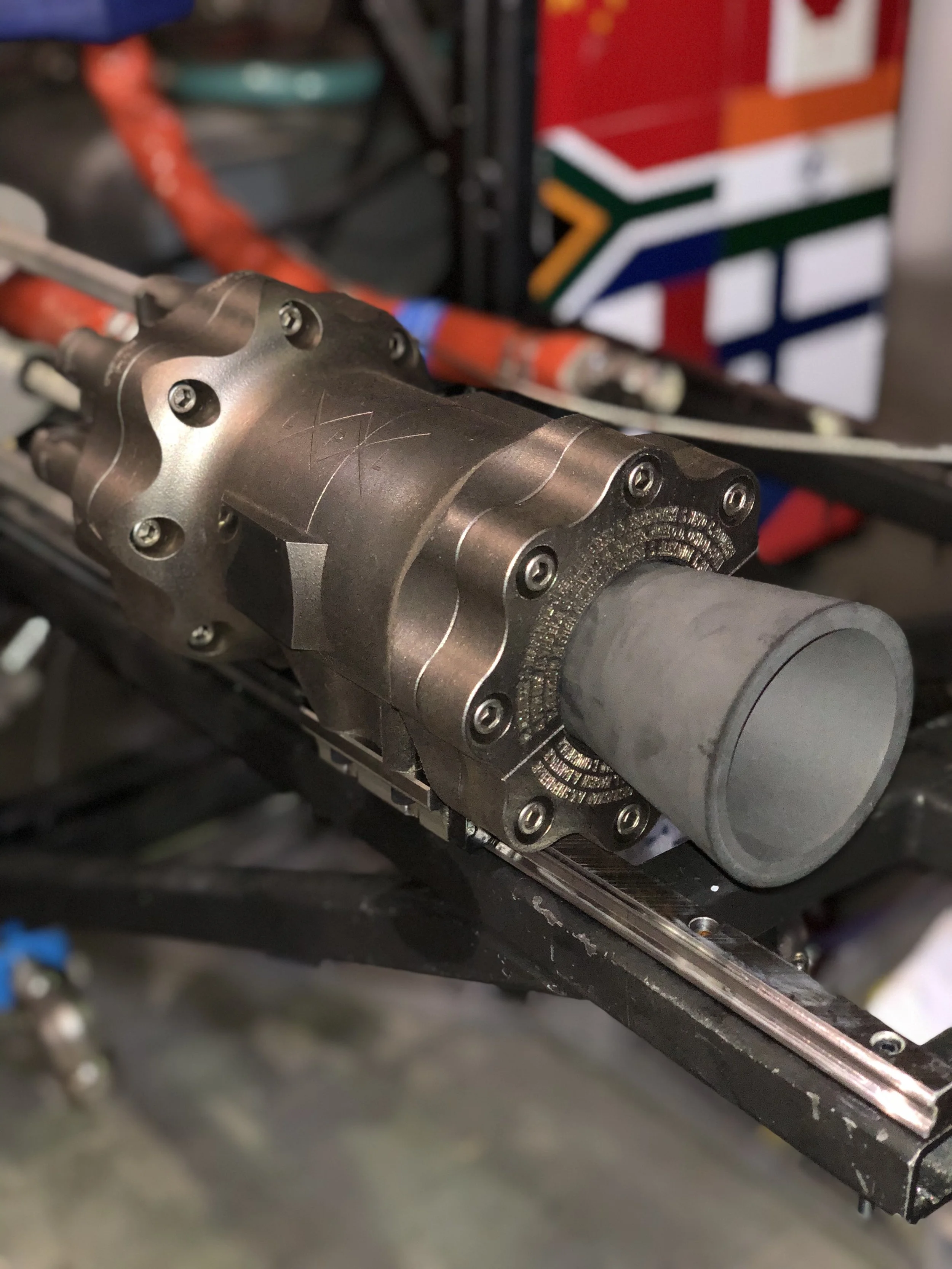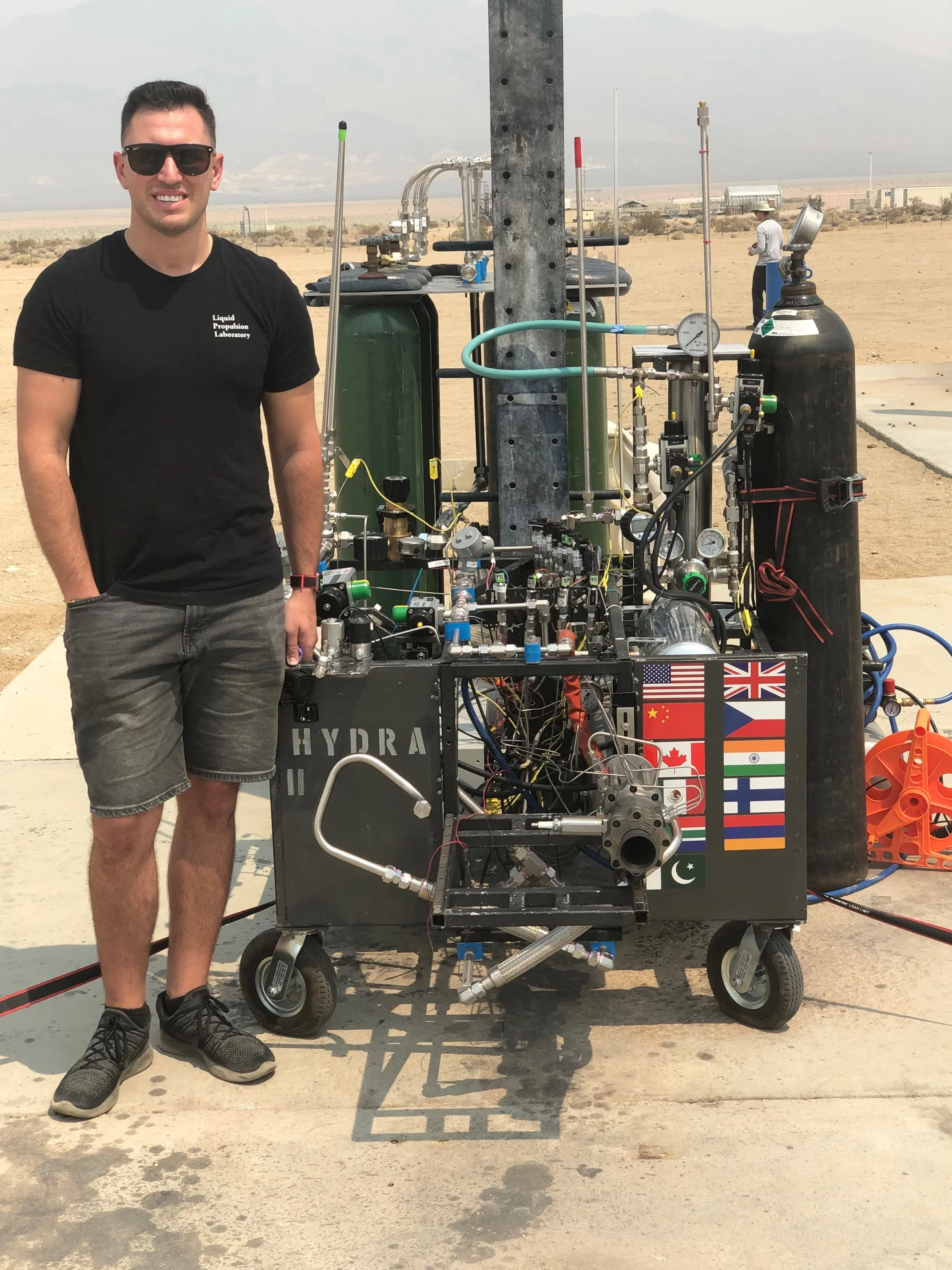Executive Summary
Below highlights a summary of some of John Targonski’s educational and professional accomplishments. The entire list of projects completed can be found under the “Projects” tab.
Spacex Propulsion EngineeR Associate
During his time at SpaceX, John improved the process of characterizing the fundamental frequency of Merlin turbine blades by semi-automating the process and removing non-value-added procedures. The previous process was a manually intensive one that took hours to index one turbine wheel. John designed, procured, assembled, and activated a test apparatus that utilized a servomotor system, COTS components, and custom components, which he was able to get fabricated internally at SpaceX within one week’s time. The instrumentation utilized was an impulse hammer to excite all frequencies and a laser doppler vibrometer to measure the surface velocity at the location of interest. The data was modeled as a single degree of freedom (SDOF) system, which gave insight to both blade-to-blade & wheel-to-wheel variation. Upon activation, John ran experimental studies on various damping materials to mitigate noise, showcased repeatability, and conducted a control-study. Within 3 months’ time, John was able to improve the Merlin turbine wheel blade characterization process from hours to minutes.
Lead Propulsion Engineer, The J&J Rocket Engines
John designed, built, and integrated a liquid rocket engine onto an existing test stand, utilizing a new manufacturing process. Due to subsidized costs, the Liquid Propulsion Laboratory relies on the internal machine shop to fabricate rocket engines, which has limited capabilities. In order to continue to design, build, and test rocket engines with increased complexity, LPL has adopted additive manufacturing. John and a colleague developed a pair of modular rocket engines, Jessie & James, that went from conception to complete assembly in 4 months and static fired in 6 months. John was able to showcase the new design space enabled by additive manufacturing and how it is ideal for rapid iteration and cost reduction. The J&J rocket engines were fabricated in a third of the time and at a 45% cost reduction when compared to subtractive manufacturing. This project also brought to the surface challenges associated with this process such as powder removal, orifice shrinkage, and FOD prevention. Jessie & James are now key articles that serve the lab as workhorse engines and can be further developed for years to come.
Spacex propulsion engineer Associate
During his time at SpaceX, John modified the Pump Water Flow Test Facility to enable optical access to aid in the study of cavitation dynamics for Raptor turbopump development. John researched various materials, cameras, and lighting that would be required to acquire useful imagery and designed hardware to house both the Raptor CH4 and LOX development inducer. Because visual access to the inducer was necessary, the application of a transparent material was required, and after a trade study acrylic was chosen over polycarbonate. This brittle material was a challenge to implement during the design process to ensure structural integrity and the ability to operate in a tight and dynamic environment. In order to reduce costs, increase lead time, and ensure quality, John decided to utilize internal machinists for all metallic parts and an external supplier for the acrylic. From that point on John transitioned to a build engineer and interfaced daily with suppliers to ensure an aggressive schedule was met. During the final week, John was able to integrate the new Raptor LOX optical housing hardware on the test rig, install new lighting acquired from Germany, and recorded SpaceX’s first ever video of pump cavitation with two demoed cameras.
LPL Test Engineer, Hydra Mobile test stand
At the Liquid Propulsion Laboratory, John introduced safety considerations as well as the procurement, fabrication, and testing process associated with feed systems. John took experience gained as Integration & Test lead from his undergraduate Lunar Lion Laboratory and expanded upon it by co-leading the design, fabrication, integration, and activation of a mobile rocket engine test stand, Hydra. Hydra would enable rapid, safe, and reliable testing that was not present before. John trained the lab on how to cut, bend, and join tubing as well as how to clean systems for oxygen use. Once Hydra was built, John introduced the lab to testing such as hydro-proof and leak and collaborated in creating thorough standard operating procedures. John ended 2017 by integrating the lab’s original rocket engine on the newly activated test stand, which saw its inaugural static fire in Mojave, California on December 2, 2017. John documented the development and significance of Hydra as a co-author of a publication called “Hydra: Development of a Liquid Rocket Engine Test Stand and Feed System” that was presented at the 2018 AIAA Propulsion & Energy Conference.
USC LPL LABORATORY Lead
In addition to leading the development of Hydra, John was officially the laboratory co-lead for the LPL during the year of 2017. John adopted a clear objective and strategy that focused on student workforce development and encouraged members to demonstrate end-to-end ownership with minimal directionas well as establishing a recruiting and on-boarding process that focused on finding and developing eager engineers. Workforce development was achieved by providing students the opportunity to take knowledge acquired in coursework and apply it in a hands-on, extracurricular setting that replicates what is seen in industry. Examples of this includes creating and maintaining 3D models using Siemens NX, developing in house codes using MATLAB and python, utilizing simulation software with ANSYS, creating drawings which adhere to GD&T standards, as well as replicating the build & test phases. He also oversaw and led in strategic planning for the design of the 10 kN development liquid-propellant rocket engine, Balerion. John’s time as lead saw tremendous growth with a 10X increase in overall lab space, 3 publications, a new state-of-the-art Water Flow Test Stand, and 3 additively manufactured engines in development. John was able to document the overall culture change and new philosophy in a publication called “The Objective & Strategy Behind the University of Southern California’s Liquid Propulsion Laboratory” that he presented at the 2018 AIAA Propulsion and Energy Conference. His overall contribution was recognized by the university as he won “Rocket Scientist of the Year” at the 2018 USC Viterbi School of Engineering Master’s Student Awards ceremony.
Integration & Test Lead, Penn State Lunar Lion Laboratory
During his undergraduate studies, John was a member of the Lunar Lion Laboratory; a student run organization derived from the Google-Lunar XPrize to design, build, and fly a spacecraft to the moon within the next decade. John was promoted in the summer of 2015 and offered a paid position as the Integration & Test Lead to help get the lab’s lander prototype, Puma, ready for its upcoming testing campaign. John was responsible to integrate, verify, and validate that Puma was a fully functional system and create a test plan to ensure a safe and successful hover test. Throughout the summer, John interfaced with subsystem leads to become the systems expert and create documentation that included requirements, design decisions, the design validation process, the construction process and procedures, and construction verification pass/fail criteria. Once the system was well understood, John proceeded to author an operational, personnel, and material readiness document which included start-up/shut-down procedures, contingencies, abort values, fluid schematics, testing roles with their prospective training requirements, a training guide, and more. On Tuesday July 21, 2015, John presented a Test Readiness Review in front of a panel of engineers from industry, EHS, and others to ensure compliance with the university to conduct a testing campaign. John spent his final year with Lunar Lion closing out action items, performing system level testing, and training members and his replacement. The Lunar Lion Laboratory went on to successfully accomplish its first hover test in October of 2016 utilizing the testing program John established.





